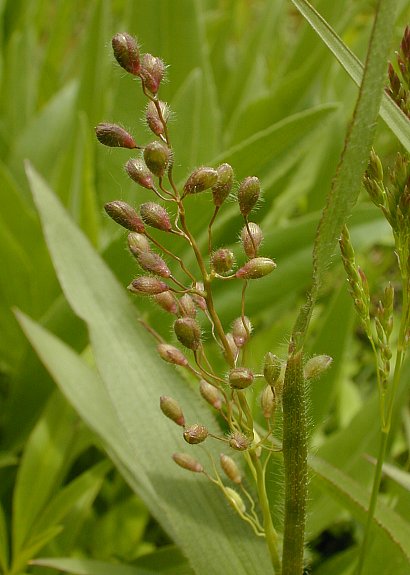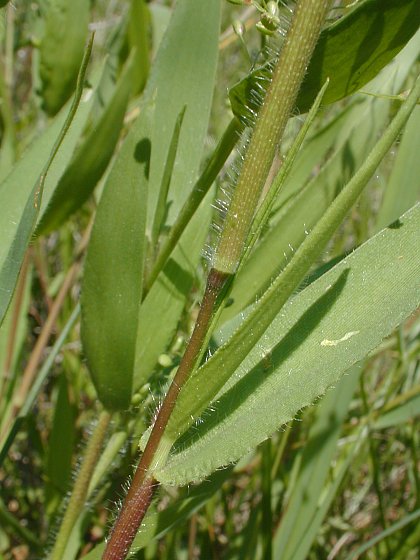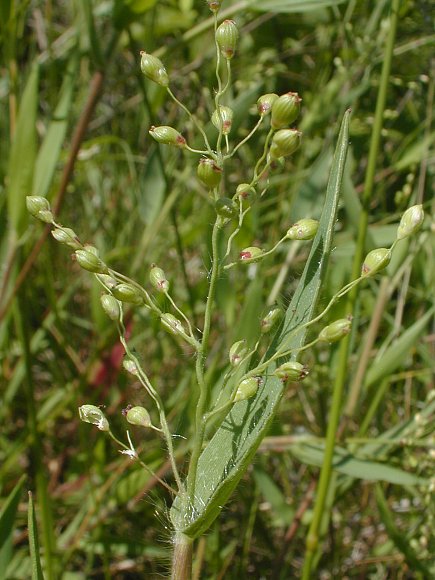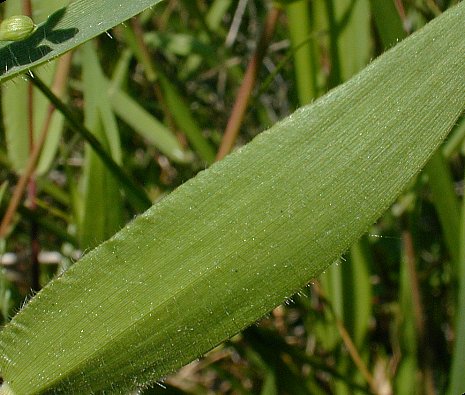Description: This perennial grass develops a culm during the spring that becomes 1-2' tall by early summer. This ascending to erect culm is unbranched, or it may have 1-2 short side branches. The culm is green or purplish green, glabrous to slightly pubescent, terete, and partially hidden by the sheaths. There are 4-6 alternate leaves along its entire length. The leaf blades are up to 3½" long and ½" (12 mm.) across (or a little more); they are dull green, flat, and ciliate along their lower margins. The upper blade surface is hairless, while the lower blade surface is hairless to sparsely appressed-pubescent. The leaf sheaths are green, purplish green, or purple; they are strongly veined and more or less covered with long spreading hairs. The bases of these hairs are swollen (papillose). The sheaths have V-shaped openings at their apices. The nodes are swollen, greenish to purplish, and more or less hairy. At the junctions of blades and sheaths, the ligules have narrow rings of fine hairs.

Each culm terminates in a panicle of spikelets about 2½" long and 1½" across on a short stalk up to 1" long. The rachis of this panicle is erect and wiry, while its lateral branches are wiry and ascending. These branches occur either individually or in whorls of 2-3 along the rachis. Sometimes small tufts of hair occur where these branches diverge. Most of the lateral branches divide into short branchlets that terminate in small spikelets. The spikelets are 3.0-3.5 mm. long and 2.0-2.5 mm. across; they are green to reddish green and glabrous to finely pubescent. Each spikelet consists of a small glume, a large glume, and a lemma that encloses the developing ovary. The small glume is about 1/3 the length of the spikelet, while the large glume and lemma are the same length as the spikelet. The blooming period occurs from late spring to mid-summer, lasting about 1-2 weeks for a colony of plants. At this time of year, the florets of the spikelets are cross-pollinated by the wind. Each mature spikelet produces a single grain. These grains are a little shorter than the length of their spikelets, ovoid-obovoid in shape, and slightly flattened along one side. Autumnal culms develop after the spring culms die down during the summer. The autumnal culms are more branched and closer to the ground; they produce smaller panicles of spikelets that are largely hidden to partially exerted from their sheaths; the florets of these spikelets are cleistogamous (self-fertile). The root system is fibrous. This grass spreads by reseeding itself.

Cultivation:
Full to
partial sun and mesic to dry conditions are preferred. This grass
adapts readily to soil that is loamy, sandy, or rocky.
Range & Habitat:
Scribner's Panic Grass is widely distributed and occasional throughout
Illinois (see Distribution
Map), where it is native. Habitats include black soil
prairies and sand prairies, savannas and sandy savannas, open rocky
woodlands, limestone glades, remnant prairies along railroads, and
abandoned fields. Because this short grass develops during the cool
weather of spring and fall, it is able to avoid direct competition with
the warm-season prairie grasses.

Faunal
Associations:
Various insects feed on Scribner's Panic Grass and other Panicum/Dichanthelium
spp. (Panic Grasses). Several species of grasshoppers have
been found to feed on Scribner's Panic Grass specifically (see Grasshopper
Table). Other insects that feed on this and other Panic
grasses include the larvae of skippers and moths, larvae of flies, leaf
beetles,
leafhoppers, aphids, stilt bugs, plant bugs, and stink bugs (see the Insect
Table for a listing of these species). The seeds of Panic
grasses in mesic to dry habitats are an important source of food to
many upland gamebirds and granivorous songbirds (see the Bird Table
for a listing of these species). Such small rodents as the Prairie Deer
Mouse and House Mouse also eat the seeds. The Cottontail Rabbit
occasionally eats the foliage of Panic grasses (particularly the
shorter species); the foliage is also edible to bison, horses, and
livestock.
Photographic Location:
A small remnant prairie along a railroad near Champaign, Illinois.

Comments: This grass should be used more often in ecological restorations because the prairie remnants and savannas where it occurs are slowly disappearing. It is a short attractive grass with unusually wide blades and large seeds. Other scientific names of this species are Panicum scribnerianum and Panicum oligosanthes scribnerianum, but it has been reassigned to the Dichanthelium genus. Scribner's Panic Grass is sometimes classified as a variety of Dichanthelium oligosanthes and it can be difficult to distinguish from the latter grass's varieties. The typical variety of Dichanthelium oligosanthes has both long spreading hairs and shorter pubescence on its sheaths, its lower leaf blades are more pubescent, and its leaf blades tend to be more narrow (up to 8 mm. across). The spikelets of the typical variety are longer (3.5-4 mm. in length) than the spikelets of Scribner's Panic Grass. Finally, var. helleri of Dichanthelium oligosanthes differs from Scribner's Panic Grass by having shorter spikelets (up to 3 mm. in length) and its foliage is more glabrous. This latter variety has been collected only once in southern Illinois. There are many other Dichanthelium spp. in the state, but they usually have smaller spikelets and grains, or their leaf blades are more narrow (less than 8 mm. across).